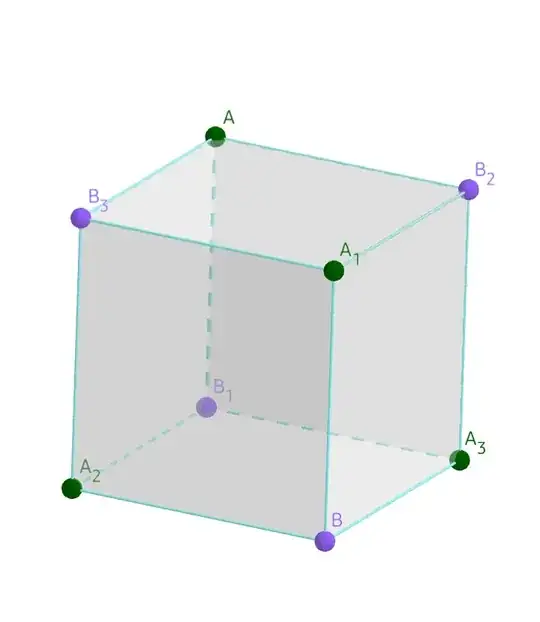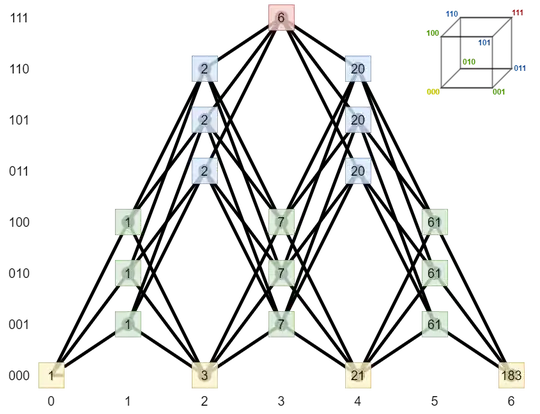
Consider the "adjacency matrix" of the cube, considered as an "undirected graph" :
$$A=\left(\begin{array}{cccccccc}
0&1&1&0&1&0&0&0\\
1&0&0&1&0&1&0&0\\
1&0&0&1&0&0&1&0\\
0&1&1&0&0&0&0&1\\
1&0&0&0&0&1&1&0\\
0&1&0&0&1&0&0&1\\
0&0&1&0&1&0&0&1\\
0&0&0&1&0&1&1&0
\end{array}\right)$$
In every column of $A$, there are 3 "ones", accounting for the three neighbouring vertices for a certain ordering of the vertices of the cube. For example, in the first column, $A_{1,2}=A_{1,3}=A_{1,5}=1$ meaning that vertex $1$ has neighbouring vertices $2,3$ and $5$, etc.
The interest of this matrix is that the generic element $P_{i,j}$ of its k-th power $P:=A^k$ gives the number of different ways one can go from vertex $i$ to vertex $j$ in $k$ steps.
For example, consider :
$$A^2=\left(\begin{array}{cccccccc}
3&0&0&2&0&2&2&0\\
0&3&2&0&2&0&0&2\\
0&2&3&0&2&0&0&2\\
2&0&0&3&0&2&2&0\\
0&2&2&0&3&0&0&2\\
2&0&0&2&0&3&2&0\\
2&0&0&2&0&2&3&0\\
0&2&2&0&2&0&0&3
\end{array}\right)$$
We indeed see that there are
3 ways to go from vertex 1 to itself in two steps (by going to one of its three neighbours then backtracking).
2 ways to go from vertex 1 to vertex 4 in two steps (indeed, they occupy two opposite vertices on a same face of the cube).
It now remains to consider, in $A^6$, the upper left entry which is $183$, somehow larger than the result you have found.
Matlab program :
clear all;close all;hold on;view(30,15);axis equal off;
V=[0,1,0,1,0,1,0,1
0,0,1,1,0,0,1,1
0,0,0,0,1,1,0,1]; % the 2^3=8 vertices of the cube
% generation of the upper part of matrix A :
A=zeros(8);
for p=1:8;
for q=p+1:8;
if (norm(V(:,q)-V(:,p))==1)
A(p,q)=1;Z=[V(:,[p,q])];
plot3(Z(1,:),Z(2,:),Z(3,:),'linewidth',5,'b');
end;
end;
end;
A=A+A'; % taking symmetry of A into account
B=A^6;
B(1,1)
text(V(1,:)+0.05,V(2,:),V(3,:)+0.15,
{'1','2','3','4','5','6','7','8'});


